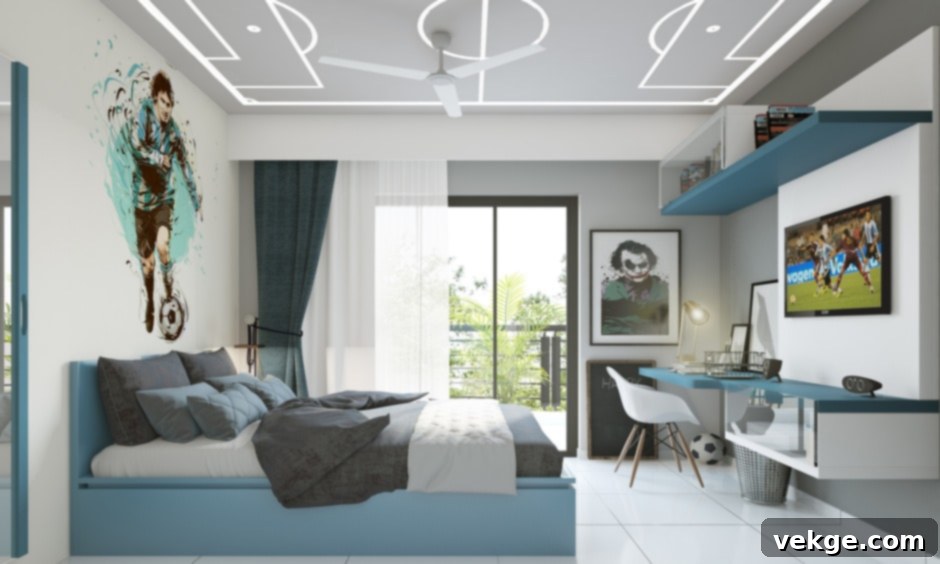Maximize Your Small Home: Ingenious Ceiling Design Ideas to Create Space and Style
In the world of interior design, every square inch counts, especially when dealing with the unique challenges and opportunities presented by small homes. While much attention is often given to walls, flooring, and furniture, the ceiling often remains an overlooked canvas. However, the right ceiling design in a compact space can be a transformative element, dramatically altering perceptions of height, depth, and overall room ambiance.
For those living in cozy dwellings or apartments with limited footprints, choosing the perfect ceiling is not merely about aesthetics; it’s about smart design. The goal is to make your home feel more spacious, inviting, and reflective of your personal style, without overwhelming the limited area. With clever planning and an understanding of how different ceiling types interact with light and color, you can unlock your small home’s full potential.
If you’ve been grappling with how to make your ceilings work harder for your compact living space, you’ve come to the right place. This comprehensive guide will explore some of the most effective and stylish ceiling design ideas specifically tailored for small homes. We’ll delve into various options, from modern false ceilings to timeless traditional looks, ensuring you find inspiration that fits your taste and budget. Beyond the designs themselves, we’ll also highlight the critical roles that lighting and color play in enhancing the visual impact of your chosen ceiling, helping you craft a truly harmonious and expansive-feeling environment.
So, let’s embark on this journey to elevate your small home, starting from the top!
Top Choices to Elevate Your Ceilings in Small Homes
Whether you’re embarking on a full renovation or simply looking to refresh a single room in your small abode, a thoughtful approach to ceiling selection is paramount. Understanding your home’s architectural style and your personal aesthetic preferences is the first step. To help you make an informed decision, it’s beneficial to explore different types of ceilings, each offering unique aesthetic and functional benefits that can be specifically leveraged for smaller areas. The right choice can dramatically enhance a room’s perceived size and comfort.
Here are some top ceiling choices designed to create a cozy, yet expansive, living space in small homes, each with its own charm and strategic advantages:
1. False Ceiling with Extended Panelling

One of the most innovative and visually striking ceiling designs for a small space involves a false ceiling integrated with extended panelling. This approach goes beyond a simple, flat false ceiling to introduce an element of architectural interest that can significantly enhance the room’s character without consuming precious floor area. Imagine a panel that begins behind your bed, mirroring the clean lines of your headboard, and then gracefully extends onto the ceiling.
This design is not only incredibly stylish but also remarkably budget-friendly, making it an accessible option for many homeowners. Its strategic placement draws the eye upwards and along the length of the room, creating an illusion of greater depth and a more expansive feel. By extending a design element from the wall onto the ceiling, you blur the boundaries of the room, making it appear larger and more cohesive. The elegance of such a design often means minimal additional decor is needed, letting the ceiling become a focal point.
To truly maximize the impact of this extended panelling, precision in lighting is crucial. Carefully placed recessed lights or LED strips along the edges of the panel can highlight its contours, add a soft glow, and contribute to the overall luxurious ambiance, turning a simple bedroom into a serene retreat. This sophisticated solution perfectly balances aesthetics with practical space-saving principles.
2. Embracing Minimalism: Simple and Elegant Ceilings
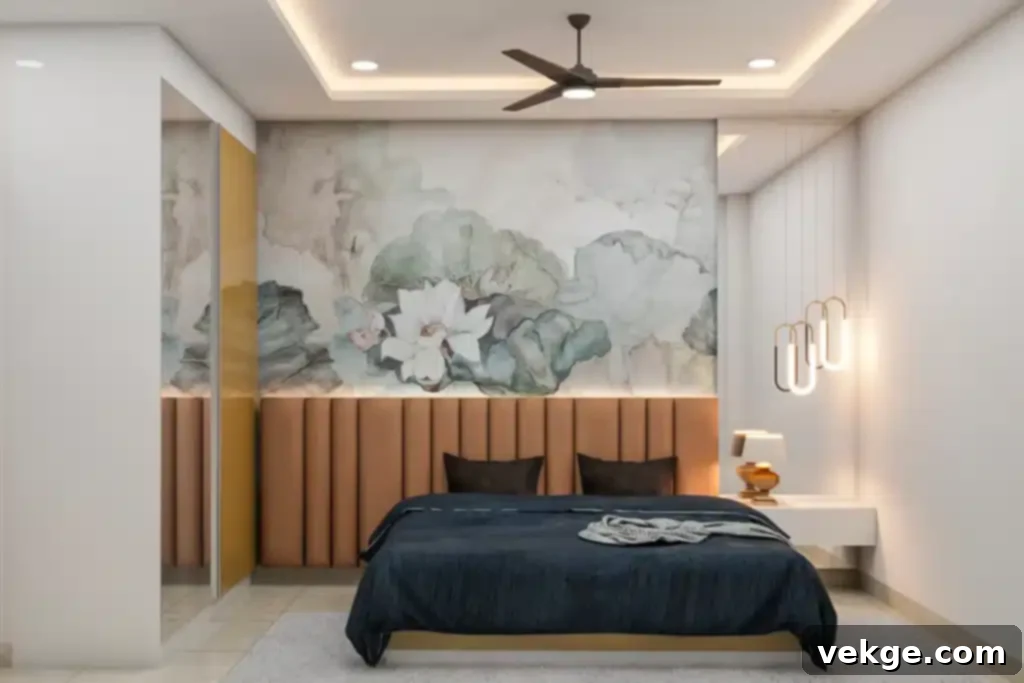
For many, the adage “simplicity is the ultimate sophistication” perfectly encapsulates their design philosophy, especially when it comes to smaller living areas. A minimalist ceiling design is ideal for homeowners who prefer a clean, uncluttered aesthetic and wish to avoid elaborate experimentation. This approach emphasizes smooth surfaces, neutral tones, and an absence of excessive ornamentation, creating a sense of calm and spaciousness.
Far from being bland, a minimalist ceiling can be incredibly pleasing and effective in compact bedrooms or living spaces. By opting for a straightforward design, you ensure that the ceiling doesn’t visually “lower” the room or compete for attention with other elements. Instead, it acts as a serene backdrop, allowing natural light to reflect freely and enhancing the room’s perceived height. The beauty of this style lies in its ability to make a small room feel airier and more open.
To add subtle interest without sacrificing the minimalist ethos, consider complementing your simple ceiling with a tastefully chosen feature wall, such as a stylish headboard wallpaper, as beautifully depicted in the image above. This creates a focal point at eye level, allowing the ceiling to recede and contribute to an overall sense of tranquility and expanse. This option for small homes consistently impresses, ensuring your room achieves a refined and elegant outlook with minimal effort, proving that sometimes, less truly is more.
3. The Enduring Charm of POP Ceilings
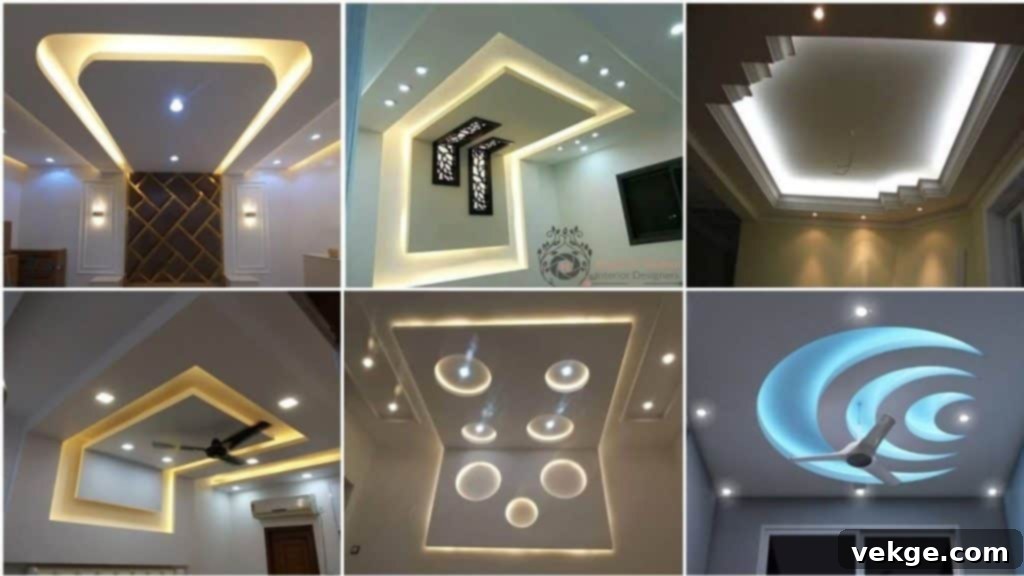
It’s impossible to discuss ceiling designs without acknowledging the timeless elegance and unparalleled versatility of Plaster of Paris (POP) ceilings. POP remains a perennial favorite due to its adaptability, allowing for an incredible array of designs that can be perfectly tailored to any space, including small homes. From subtle cove lighting designs that create a soft glow to intricate 3D patterns and bold geometric textures, POP offers endless possibilities for personalization.
For smaller rooms, POP ceilings excel at adding character and sophistication without overwhelming the space. They can be designed with recessed lighting to maintain a clean look and avoid bulky fixtures, or with layered panels that add visual depth and interest. The key is thoughtful planning to ensure the design enhances rather than detracts from the room’s perceived size. Choosing lighter colors for POP designs helps in reflecting light, further contributing to an airy atmosphere.
The multiple options showcased in the image above provide a perfect illustration of the stunning results POP can deliver when integrated with proper planning. Whether you opt for simple borders, central medallions, or more complex patterns, POP can transform a plain ceiling into a work of art. However, as with any ceiling choice, the integration of lighting is paramount. Ensure that your chosen lighting scheme complements the POP design, highlighting its features and providing adequate illumination, which is especially important in compact areas to brighten and expand the space.
4. Warmth and Texture with Slim Wooden Panels for Ceilings
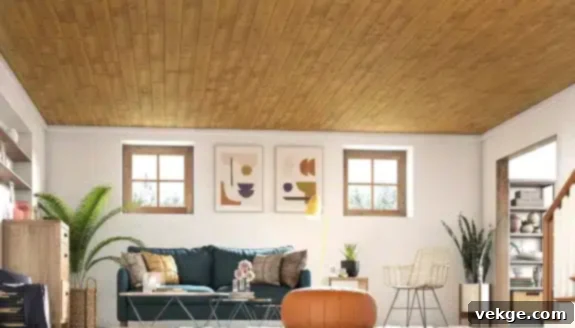
Wood has an inherent ability to infuse any space with warmth, texture, and a timeless sense of natural elegance. For compact rooms, wooden ceiling ideas, particularly those featuring slim panels, present an excellent option for creating a cozy and sophisticated ambiance. Unlike heavier, more traditional wooden beams, slim panels offer the aesthetic appeal of wood without making the ceiling feel too imposing or heavy in a smaller area.
These panels can be installed in various orientations to influence the room’s perceived dimensions. Running them lengthwise can visually elongate a narrow room, while a carefully chosen pattern can add unique character. You might opt for lighter wood tones, such as maple or birch, to keep the room feeling bright and open, especially if the panels cover the entire ceiling. Alternatively, for a more dramatic and intimate atmosphere, darker panels, like walnut or deep oak, can be used to intensify the room’s overall feel, creating a luxurious and formal touch that still retains a comforting warmth.
With this kind of setup, rooms often feel inherently cozier, more formal, and profoundly relaxing. The combination of modern design with the traditional touch of natural wood provides a unique aesthetic that is both inviting and refined. Integrating subtle lighting, such as recessed spotlights between panels or indirect LED strips, can further enhance the texture and warmth of the wood, transforming your small space into a truly captivating sanctuary.
5. The Illusion of Grandeur: Go All White for Spaciousness
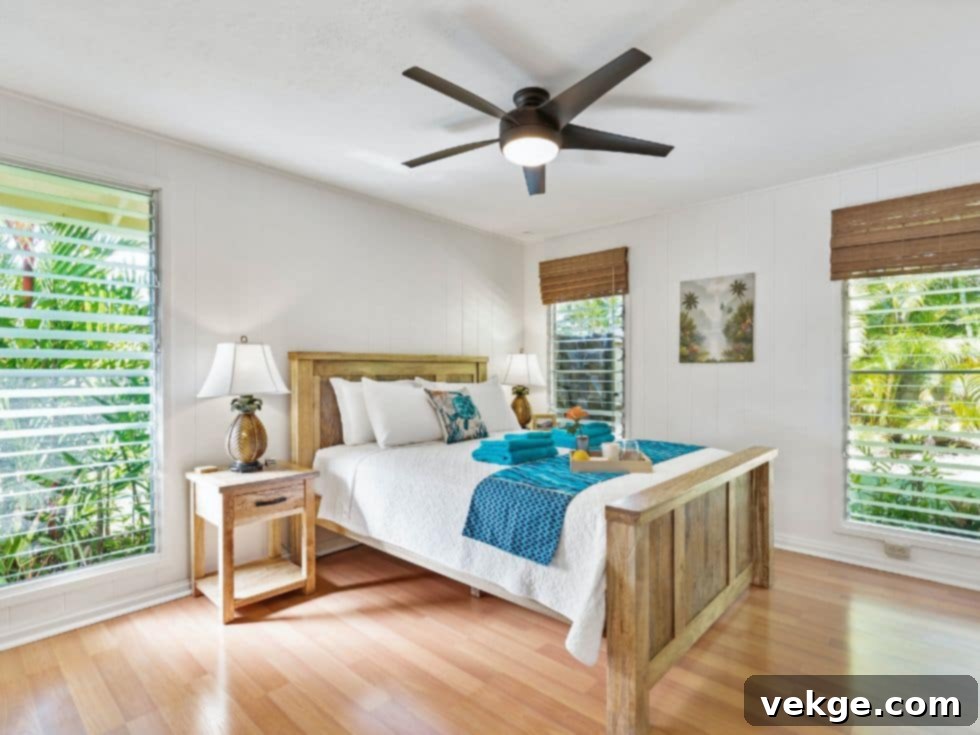
In interior design, it’s not always about elaborate looks; functionality and utility play an equally important role, especially in small living spaces. When the primary goal is to make a compact room feel larger, taller, and more open, an all-white ceiling is an unbeatable choice. This strategy is a time-honored trick of the trade, creating a perfect illusion of expanded space.
White ceilings reflect light more effectively than any other color, bouncing both natural and artificial light throughout the room. This increased light dispersion immediately brightens the space and visually pushes the ceiling upwards, making the room feel significantly more airy and capacious. When combined with light-colored walls, an all-white ceiling creates a seamless transition, further blurring the lines between wall and ceiling and enhancing the feeling of openness.
As beautifully depicted in the image above, a room with a white ceiling often needs little else to feel complete and elegant. The simplicity itself becomes a statement. A properly positioned fan with integrated lighting maintains the clean lines while providing essential airflow and illumination. You can easily personalize this theme by adding subtle textures, architectural moldings, or even wall art to bring in color and character without compromising the spacious feel. Moreover, incorporating an airy setup in your room, with minimal clutter and strategic furniture placement, will only work as an added advantage, reinforcing the illusion of grandeur and making your small home feel truly expansive.
Beyond Design: The Crucial Role of Lighting and Color
While the structural and material choices for your ceiling are fundamental, the strategic application of lighting and color can dramatically amplify the positive effects of your chosen design in a small home. These elements work in tandem to manipulate perception, making a room feel larger, brighter, and more inviting.
Strategic Lighting for Enhanced Space
Lighting is perhaps the most powerful tool for transforming a small room. Recessed lighting, such as pot lights or LED panels, is highly recommended as it keeps the ceiling surface flush and uncluttered, preventing any visual obstructions that might make the room feel lower. Cove lighting, where LED strips are hidden within a false ceiling or molding, casts a soft, diffused glow upwards, highlighting the ceiling and creating an ambient light that expands the sense of space.
Avoid heavy, dangling light fixtures that can visually drop the ceiling. Instead, opt for sleek, minimalist pendants if you must have a central fixture, or rely on a combination of perimeter lighting and task lighting to illuminate specific areas without weighing down the overall aesthetic. Integrating smart lighting systems allows you to control brightness and color temperature, further tailoring the room’s mood and perceived size throughout the day.
Color Psychology and Ceilings
The color of your ceiling plays a pivotal role in dictating the mood and perceived dimensions of a room. For small homes, lighter colors are almost always the preferred choice. White, as discussed, is the ultimate space expander due to its high reflectivity. However, you aren’t limited to pure white.
Consider soft off-whites, very pale grays, or even a shade lighter than your wall color. Painting the ceiling a slightly lighter hue than your walls helps to lift the ceiling visually, creating a gentle gradient that draws the eye upwards. Using a high-gloss paint finish can also enhance light reflection, adding a subtle sheen that makes the ceiling appear more distant and spacious. Conversely, while bold or dark ceilings can create drama, they are generally best avoided in very small rooms unless used strategically with very high ceilings or specific design goals, as they tend to absorb light and make a room feel smaller and more enclosed.
Final Words
Choosing the right ceiling for small homes is a critical decision that profoundly impacts both the functionality and aesthetic appeal of your living space. Far from being a mere overhead surface, the ceiling holds immense potential to maximize space, introduce unique design elements, and significantly improve your home’s overall look.
Among the myriad of options, several key approaches stand out for their effectiveness in compact environments. False ceilings with extended panelling can add a dramatic and modern touch without overwhelming the space, cleverly using visual lines to create a sense of expanse. For those who prioritize tranquility and an uncluttered feel, embracing a minimalist ceiling design is often the best approach, fostering an open and serene atmosphere.
If you’re seeking traditional elegance combined with unmatched versatility, the enduring charm of POP ceilings offers endless possibilities for custom patterns, textures, and integrated lighting. Alternatively, slim wooden panels can infuse your room with natural warmth and sophisticated texture, balancing modern living with a touch of the timeless. And for the ultimate illusion of grandeur and openness, an all-white ceiling remains an unbeatable strategy, making any small room feel larger and brighter.
Regardless of the specific option you choose, remember that the success of your ceiling design hinges on thoughtful planning and attention to detail. Integrate elements that are not only visually appealing but also contribute to the functionality of your space. Do not compromise on practical considerations for the sake of aesthetics alone. The interplay of your chosen ceiling design with strategic lighting and color will ultimately determine how well your small room is transformed into a comfortable, spacious, and stylish haven.
We sincerely hope this guide has provided valuable insights and made the process of selecting the perfect ceiling for your small home a much easier and more inspiring endeavor.
Frequently Asked Questions
1. Which Type of Ceiling is Best for a Home?
For many homes, especially considering modern needs for insulation and aesthetics, gypsum ceilings often present the best all-around solution. This material offers excellent thermal insulation properties, helping to regulate room temperature effectively. The air-filled gap created between the structural ceiling and the gypsum-based false ceiling acts as a buffer, trapping cool air within the room during warmer months and preventing heat loss in colder periods. This insulation property not only contributes to comfort but can also lead to energy savings. Furthermore, gypsum is versatile, allowing for smooth finishes, integrated lighting, and a variety of design possibilities.
2. What is the New Trend for Ceilings?
The prevailing new trend in ceiling design is “ceiling maximalism.” This approach encourages homeowners to view the ceiling not as a fifth wall to be ignored, but as a bold design opportunity. Maximalist ceilings are designed to make a statement, often incorporating rich wallpaper, vibrant bold colors, intricate decorative molding, unique textures, or even a high-gloss sheen to reflect light and add drama. This kind of ceiling idea elevates a room’s overall look to an entirely new level, pushing boundaries beyond traditional flat white surfaces. For those embarking on a new project or seeking to inject personality, choosing a maximalist design from the ideas presented above can perfectly match this exciting new trend.
3. Which Type of Ceiling is Cheaper?
Generally, conventional or flat ceilings (standard plaster or drywall directly attached to joists) are the most economical option. Their simplicity of construction and minimal material requirements make them a favorite choice for developers and homeowners on a budget. Beyond their initial economic benefits, flat ceilings are straightforward to maintain and offer immense flexibility, serving as a neutral canvas that can be painted to match almost any color scheme or textured finish you wish to incorporate. While they may lack the intricate designs of false ceilings, their cost-effectiveness and ease of installation are undeniable advantages.
4. What are the Disadvantages of PVC Ceilings?
While PVC ceilings offer benefits like moisture resistance and durability, they do come with certain disadvantages. A primary concern is their potential to release toxic gases. Since chlorine is a key component in the production of PVC materials, there is a possibility that trace amounts of toxic chlorine gas could be released into the air over time, especially under specific conditions like heat exposure. Furthermore, PVC materials are combustible and can release harmful fumes when burnt. For this reason, it is generally advised not to use them in areas prone to high heat, such as kitchens, where the risk of fire or heat degradation is higher, potentially compromising indoor air quality and safety.
